Growth of GDP per capita (1985-94)
Country Growth of GDP per capita Country Growth of GDP per capita
There is a definite connection between the level of countries income and the structure of it’s production. Poor countries tend to have a high percentage of production in the primary sector. When the income of a country increases, the production shifts from the primary sector to the secondary or manufacturing sector and with even higher rise of income the production shifts into the tertiary or services sector. The table below illustrates this characteristic in low, middle and high income countries.
Structure of Production (1990)
Per capital GDP Distribution of GDP %
The production on the land is very low in the LDCs, yet many more people work in live in the rural sector, than the GDP distribution percentages suggest. All in all, 66% of people from LDCs live in rural sector whereas only 27% of MDCs live in it. In LDCs countries primary exports form the major source of foreign exchange earnings. As the economies in the world grow, the percentage share of primary products in total world trade falls, such in 1950 there was 33% of total, and by 1986 fall to 23%. Primary products are income inelastic. In order for output to grow, factor inputs must either increase in quantity or in quality, or both. Which still doesn’t ascertain the growth of a poor country. In order to grow, which also stands for willing to change and raise the standards of living, human attitudes and human institutions play a big role in the change.
Professor Simon Kuznets was one of the establishers of the characteristics which came upon in his studies about economic growth. Those characteristics are: GDP growth, GDP per capita growth, population growth, productivity growth, structural transformation, international trade and social and ideological change. Since the start of the industrial revolution, which leads back to the point that historical evidence helps to identify the requisite necessary for the process of growth, developed countries have averaged rates of growth of 3% of GDP, 1% of population and 2% of GDP per capita. This data has largely increased on the rates of all earlier periods. Huge gains in output which accounted the increase in productivity, caused by technological change, including improve in human skills. Those changes were gained by a different shift in the structure of production. The economic emphasis shifted from primary to secondary, and thereafter to tertiary output. Small family productions developed so far that they gave away to large impersonal companies. Therefore the families moved from countryside to live in cities or towns. International trade grew enormously during the growth process. Industrialising countries searched for raw materials and for markets. This was established by force and by colonisation. Growth, spread less widely, affecting only about a third of world’s population. There were changes in beliefs, ideologies and institutions. Traditional ideas were taken over by modern ideas., where modern was considered ‘rational’, ‘scientific’, ‘ordered’ and ‘change oriented’.
Rapid growth coming from increase of production, longs for further economic research for growth and change, which brings further growth. Shown underneath.
1. Growth
Research +
Development
When the rate of production grows it raises the incomes, which then raises the demand for goods and services. <this makes markets grow and develop further. Seen below.
- Growth
Raises incomes
Stimulates Markets
Raises Demand
When incomes rise, the growth for income-elastic industrial products grow faster. Therefore the demand for inelastic agricultural goods rise as well. This causes the production move from the farm to the factory. As people move from rural living to urban living, which brings up urbanisation. Causing breakdown of Traditional Values.
3. Growth
Demand for Industrial Goods rather than Agricultural
Breakdown of Traditional Values
Industrialization & Urbanization
All these characteristics are inter-dependant and self-reinforcing. Growth is an important target, since it enables development. Economic growth can create resources witch can reduce poverty. Economic growth raises the standard of living. All the facts above show us the characteristics of economic growth. This shows once more the importance of economic growth for this world’s economies.








